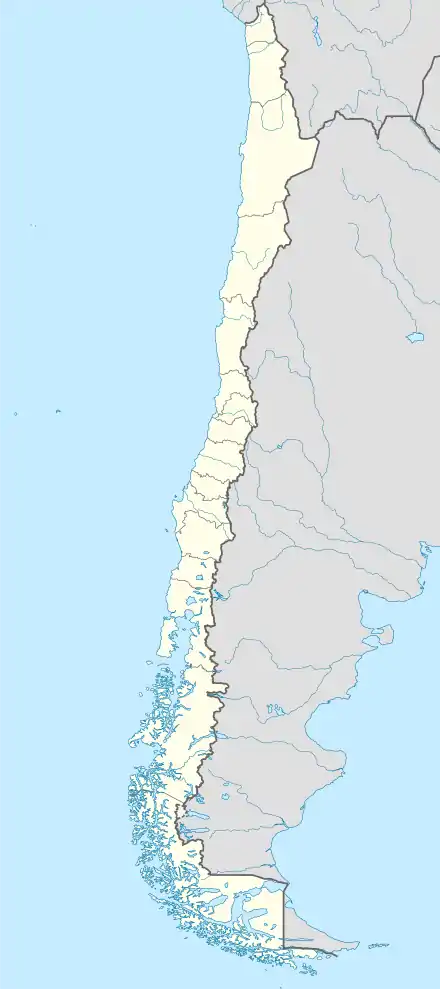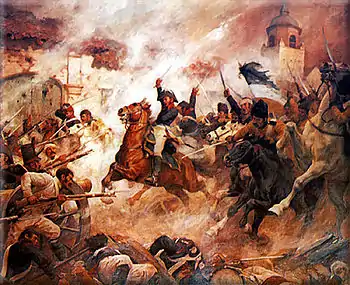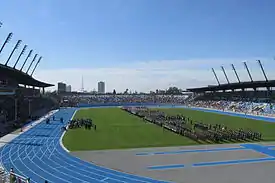Rancagua
Rancagua (Spanish pronunciation: [raŋˈkaɣwa]) is a city and commune in central Chile and part of the Rancagua conurbation. It is the capital of the Cachapoal Province and of the O'Higgins Region, located 87 km (54 mi) south of the national capital of Santiago.
Rancagua | |
|---|---|
| Ciudad de Rancagua | |
 Buildings surrounding Los Héroes Square, Rancagua. Top: Southern view of the plaza, Middle: Cachapoal Province Governorate, Bottom left. Sagrario Cathedral, Bottom right: Bernardo O'Higgins monument. | |
 Coat of arms  Map of Rancagua commune in O'Higgins Region  Rancagua Location in Chile | |
| Coordinates (city): 34°10′S 70°45′W | |
| Country | |
| Region | |
| Province | Cachapoal Province |
| Foundation | October 5, 1743 |
| Government | |
| • Type | Municipality |
| • Alcalde | Eduardo Soto |
| Area | |
| • Total | 260.3 km2 (100.5 sq mi) |
| Elevation | 572 m (1,877 ft) |
| Population (2012 Census)[1] | |
| • Total | 232,211 |
| • Density | 890/km2 (2,300/sq mi) |
| • Urban | 206,971 |
| • Rural | 7,373 |
| Demonym(s) | Ranquigüian |
| Sex | |
| • Men | 104,879 |
| • Women | 109,465 |
| Time zone | UTC−4 (CLT) |
| • Summer (DST) | UTC−3 (CLST) |
| Postal code | 2820000 |
| Area code(s) | 56 (country) + 72 (city) |
| Police | Carabineros de Chile |
| International airports | Rancagua de la Independencia |
| Climate | Csb |
| Website | www |
It was originally named Santa Cruz de Triana by Spanish colonists. In 2012, its population was 232,211.[1] The main economic activities range from mining, tourism, agriculture, timber, food production and services to minor industrial activities. The city also serves as the administrative and legal center of the region.
Together with Machalí and Gultro, it forms the Rancagua conurbation. After Curicó, Talca and Concepción, it is one of the most important and densely populated cities of the south central zone of Chile.
History
Foundation period

The Rancagua Valley was occupied by the local Picunche. They fell briefly under the control of the Inca Empire in the 15th century. Its remains in structures can still be found near the city today.[2] Through their civil engineering, the Inca accomplished expeditions to the south of their empire.
Rancagua was founded by Spanish explorer José Antonio Manso de Velasco, who founded several cities in the central area of Chile. The settlement was first called Villa Santa Cruz de Triana.
The city is notable in Chilean history as the scene of the Disaster of Rancagua of 1814, when Chilean forces fighting for independence from Spain were defeated. This marked the beginning of the period known as the Reconquista (Reconquest), an attempt by Spain to regain control of Chile.
Today

In recent years the city has become one of the most attractive cultural and tourist centers in the O'Higgins Region, largely because of the vineyards that have been developed in the area. Rancagua also offers sports centers and easy access to smaller villages and towns.
Other visitors are attracted to the archeological sites, such as Pukara de La Compañia and the nearby Rio Cipreses nature reserve. Both can be visited by private vehicle or with local tour companies.
The city is connected to the capital, Santiago, by the Panamerican Highway (Chile Route 5). In addition, the Metrotren connects the metro service in Santiago to Rancagua by train.
Rancagua is home of the University of Rancagua, the first private university to be established in the O'Higgins Region.
The region is known for El Teniente in the nearby Andes mountain range: it is the "largest underground copper mine in the world."[3] It is located about 40 km (25 mi) to the east of the city. El Teniente is a division of the state-owned mining enterprise, Codelco.
The city's Braden Copper Stadium, named for the American company that developed the mine through the first half of the 20th century, was one of the four venues of the 1962 FIFA World Cup. More recently, it houses the O'Higgins professional football (soccer) club, one of the leading teams in Chilean professional football. Every year, the National Championship of Chilean rodeo is held in the Medialuna Monumental de Rancagua. In 2015, the city hosted the 2015 Copa América, receiving two matches of the tournament.
Demographics

The population of Rancagua is primarily either of Spanish descent or mestizo, with a particularly strong Basque influence. There are also residents of German, Croatian, Italian, Greek, Levantine Arab, Swiss, French, English or Irish ancestry living in the city.[4] Indigenous Mapuche workers migrate from the south[1] and there are also some Roma gypsies.
In addition, there has been increasing immigration to the city from neighbouring South American countries such as Bolivia, Colombia and Peru.[1] According to the 2002 census of the National Statistics Institute, Rancagua spans an area of 260.3 km2 (101 sq mi) and has 214,344 inhabitants (104,879 men and 109,465 women). Of these, 206,971 (96.6%) lived in urban areas and 7,373 (3.4%) in rural areas. The population grew by 14.4% (27,020 persons) between the 1992 and 2002 censuses.[1]
Notable people born in Rancagua
- Germán Riesco (1854–1916), President of Chile between 1901 and 1906.
- Lucho Gatica, bolero singer.
- José Victorino Lastarria (1817–1888), writer and politician.
- Mariano Díaz, photographer, graphic designer, and writer.
- Clarence Acuña, ex-footballer.
- Bryan Rabello, footballer.
- Mario Núñez, ex-footballer.
Administration
As a commune, Rancagua is a third-level administrative division of Chile, administered by a municipal council and headed by an alcalde, who is directly elected by the people for a four-year term.
Within the electoral divisions of Chile, Rancagua is represented in the Chamber of Deputies by Alejandro García-Huidobro (UDI) and Juan Luis Castro (PS) as part of the 32nd electoral district, which consists entirely of the Rancagua commune. The commune is represented in the Senate by Andrés Chadwick Piñera (UDI) and Juan Pablo Letelier Morel (PS) as part of the 9th senatorial constituency (O'Higgins Region).
Culture
This area is known as the "huaso province" after the name of the Chilean cowboy, the huaso. The population is a mixture of both European (including Argentine immigrants) and indigenous races and cultures. The region has a homogeneous culture known as Chileanidad and a mestizo influence is evident.
Rancagua and the Libertador General Bernardo O'Higgins Region was settled by Spaniards (notably Andalusian, Basque, Aragonese and Navarrese) and other Europeans. French and Italian families established agriculture, including the important wine industry: the Wine Route is one of the main tourist attractions of the Colchagua valley. Breweries can be found as well, the legacy of German and Swiss immigration. Livestock development and herding was especially influenced by British, Greek and Yugoslavian settlers.
Because the city is relatively close to Santiago, there has led to a growing urban influence in the local culture. Rancagua is fast becoming a suburb of Santiago's upper-class professional workforce.
Festivals
| Date | English Name | Spanish Name | Notes |
|---|---|---|---|
| 1–2 October | Disaster of Rancagua | Desastre de Rancagua | In memory of the Battle of Rancagua which occurred in 1814 |
Transportation
Public Transport is provided by Trans O'Higgins by six lines of busses.
Climate
Rancagua has a Mediterranean climate (Köppen Csb), with clearly marked seasons. Summers are generally extremely dry, with cool mornings and hot afternoons, while winters are mild with cold mornings and occasional periods of heavy rainfall that averages around 510 millimetres or 20.08 inches each year – almost all of which occurs during a handful of storms between May and August. In some years there can be a little snow.
| Climate data for Rancagua | |||||||||||||
|---|---|---|---|---|---|---|---|---|---|---|---|---|---|
| Month | Jan | Feb | Mar | Apr | May | Jun | Jul | Aug | Sep | Oct | Nov | Dec | Year |
| Record high °C (°F) | 39 (102) |
35.7 (96.3) |
36 (97) |
32.3 (90.1) |
31 (88) |
26 (79) |
28 (82) |
29 (84) |
32 (90) |
33.3 (91.9) |
34.7 (94.5) |
38 (100) |
39 (102) |
| Average high °C (°F) | 30 (86) |
30 (86) |
27 (81) |
23 (73) |
18 (64) |
15 (59) |
15 (59) |
16 (61) |
18 (64) |
22 (72) |
26 (79) |
28 (82) |
22.3 (72.1) |
| Daily mean °C (°F) | 21 (70) |
20.5 (68.9) |
18.5 (65.3) |
15 (59) |
11.5 (52.7) |
9 (48) |
8.5 (47.3) |
10 (50) |
11.5 (52.7) |
14.5 (58.1) |
17.5 (63.5) |
19.5 (67.1) |
14.7 (58.5) |
| Average low °C (°F) | 12 (54) |
11 (52) |
10 (50) |
7 (45) |
5 (41) |
3 (37) |
2 (36) |
4 (39) |
5 (41) |
7 (45) |
9 (48) |
11 (52) |
7.3 (45.1) |
| Record low °C (°F) | 5.4 (41.7) |
5 (41) |
3.5 (38.3) |
−1.8 (28.8) |
−5.9 (21.4) |
−6.2 (20.8) |
−4.9 (23.2) |
−6.2 (20.8) |
−2.3 (27.9) |
−3 (27) |
1.6 (34.9) |
3.3 (37.9) |
−6.2 (20.8) |
| Average rainfall mm (inches) | 0 (0) |
4 (0.2) |
11 (0.4) |
22 (0.9) |
70 (2.8) |
125 (4.9) |
144 (5.7) |
92 (3.6) |
27 (1.1) |
10 (0.4) |
6 (0.2) |
0 (0) |
511 (20.2) |
| Average rainy days | 0 | 1 | 1 | 2 | 4 | 6 | 6 | 5 | 3 | 2 | 1 | 0 | 31 |
| Source: MSN[5] | |||||||||||||
Sports

The sport in the city is varied including football, basketball and hockey. The city's most famous football club is O'Higgins, who currently plays in the first category of Chilean soccer, the Primera División de Chile. O'Higgins had great past glories, with the help of El Teniente they became one of the leading teams of Chile during the 1970s, participating on several occasions in the Copa Libertadores, their best performance being a semifinal appearance. In 2013, they won the Primera División de Chile for the first time, followed by a win in the Supercopa de Chile in 2014. Amongst other football clubs in the city are Tomás Greig and Enfoque, both of which play in the Tercera División de Chile.
Since 2015 the Autódromo Internacional de Codegua in the neighboring commune of Codegua held the Chile Grand Prix in the Superbike World Championship, the circuit will also hosted races in the 2016 Grand Prix motorcycle racing season.
Stadiums and arenas
- Estadio El Teniente, host of the 1962 FIFA World Cup and 2015 Copa América.
- Medialuna Monumental de Rancagua, host the Campeonato Nacional de Rodeo and Davis Cup.
- Autódromo Internacional de Codegua, will be held the Moto GP.
- Gimnasio Hermógenes Lizana
- Estadio Municipal de Rancagua
- Gimnasio Asociación de Básquetbol de Rancagua
- Estadio Guillermo Saavedra
International relations
Photo gallery
 Los Heroes Square
Los Heroes Square Bernardo O'Higgins Monument.
Bernardo O'Higgins Monument. Rancagua cathedral at night.
Rancagua cathedral at night. Paseo Independencia, Rancagua
Paseo Independencia, Rancagua O'Higgins Region District Council
O'Higgins Region District Council Cachapoal province government's building.
Cachapoal province government's building.
References
- "National Statistics Institute" (in Spanish). Retrieved November 29, 2010.
- Miranda Salas, Felix. Historia de Rancagua (PDF).
- "Copper Mining in Chile". Copper Investment News. Retrieved 30 October 2012.
- "About Chile & Its People". O'Higgins Tours.
- "Monthly averages for Rancagua". MSN. 2007. Archived from the original on 21 June 2008. Retrieved 10 January 2008.
- El Rancaguino, «Rancagua recibió a sus hermanos de la ciudad coreana de Paju»
- Noticiario Local de Extremadura, 1/08/03, «El Ayuntamiento de Miajadas firma un Convenio de colaboración con la localidad chilena de Rancagua.» Archived 2012-01-18 at the Wayback Machine
- "Bielsko-Biała – Partner Cities". © 2008 Urzędu Miejskiego w Bielsku-Białej. Retrieved 2008-12-10.
External links
| Wikimedia Commons has media related to Rancagua. |
- (in Spanish) Municipality of Rancagua
- (in Spanish) Official Newspaper`s City Website
- (in Spanish) Non-Official Website of Rancagua`s Soccer Team
